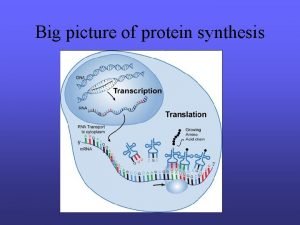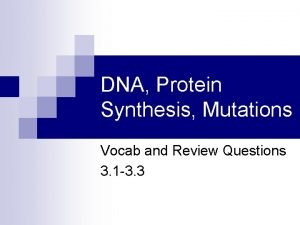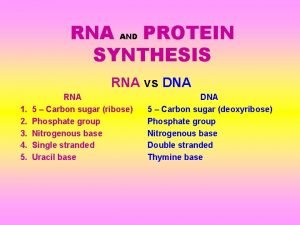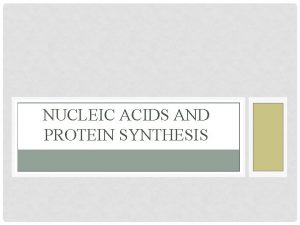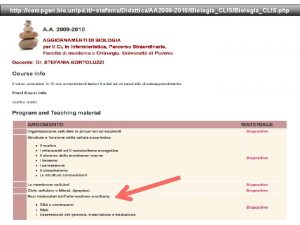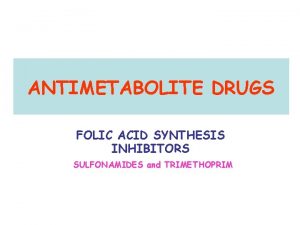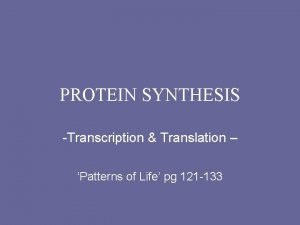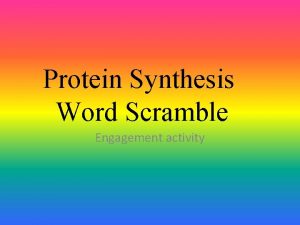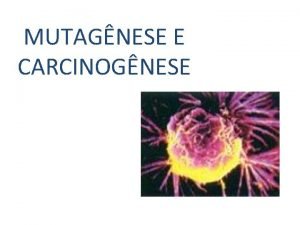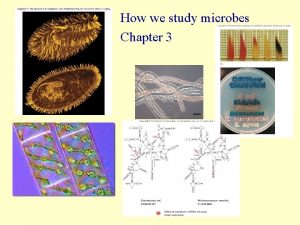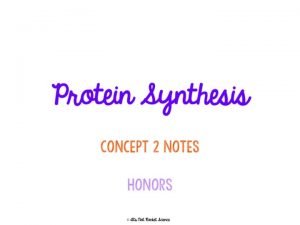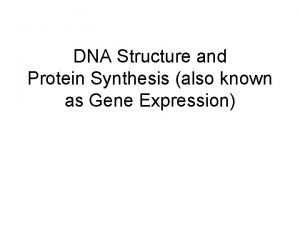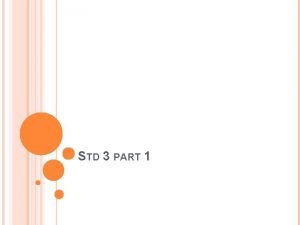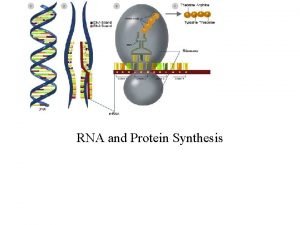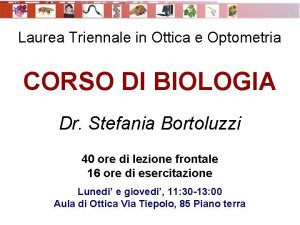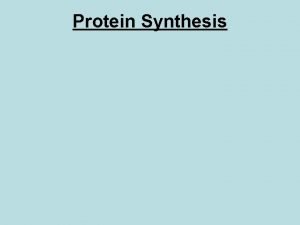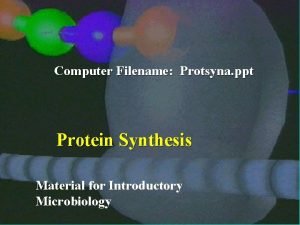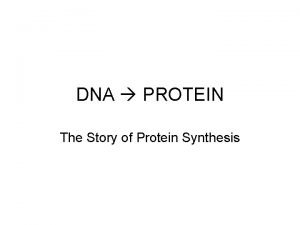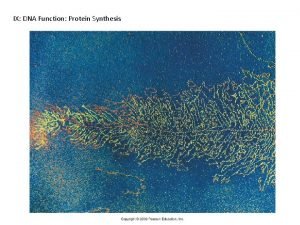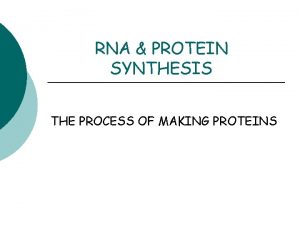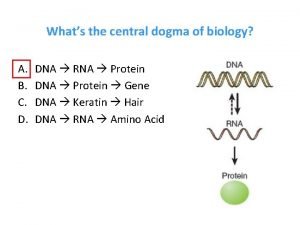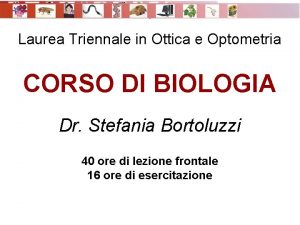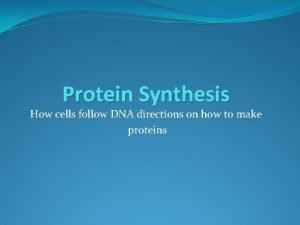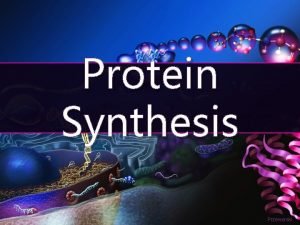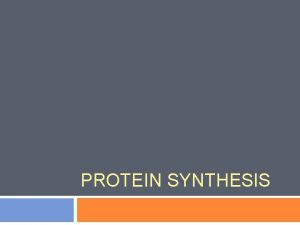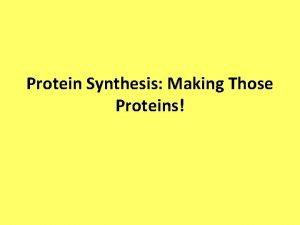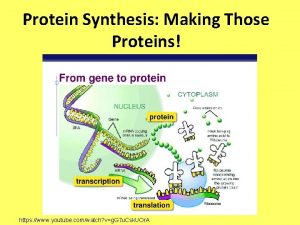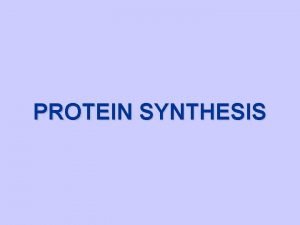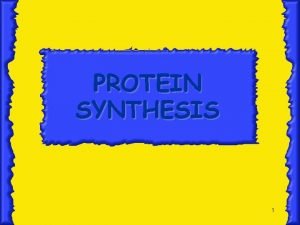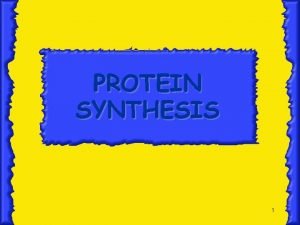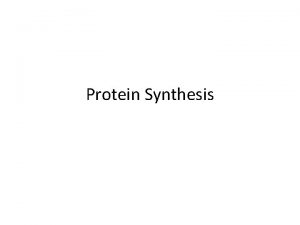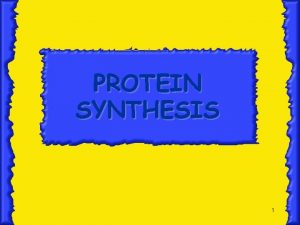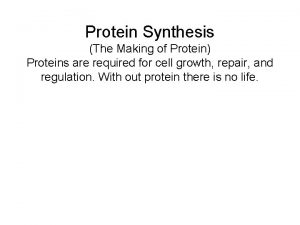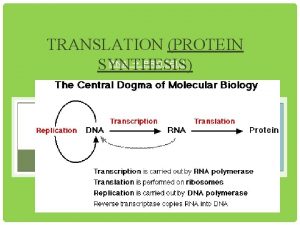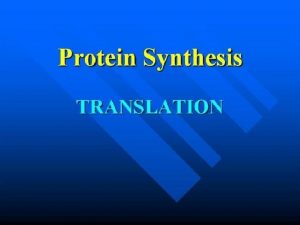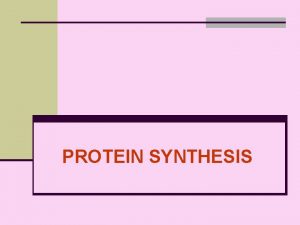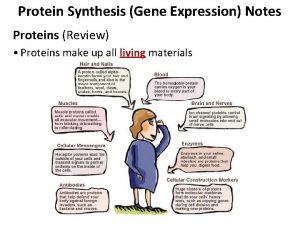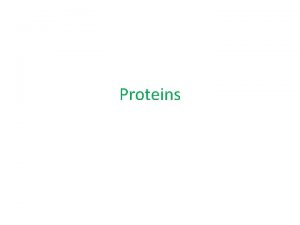Protein Synthesis Making Those Proteins So What are












































- Slides: 44

Protein Synthesis: Making Those Proteins!

So What are Proteins? • Proteins are the “work-horses” of the cell…they do a lot of different jobs! A) Antibodies – immune system (defense) B) Structure – hair and nails C) Speeding Up Reactions – enzymes D) Transport – hemoglobin (in blood) E) Movement – muscle And the list goes on!

How do our cells make proteins? • DNA contains genes, sections of nucleotide chains • Genes code for polypeptides (proteins) • Polypeptides are amino acid chains

• DNA is found inside the nucleus, but proteins are made in ribosomes • The Dilema: So how do we get the message from DNA in the nucleus to the ribosomes?

The Solution? • A molecule called RNA carries the message from the nucleus to the cytoplasm! • Unlike DNA, RNA is small enough to fit through the pores in the nuclear membrane

Roles of DNA and RNA • DNA is the master plan • RNA is the copy of the master plan!

Differences between DNA and RNA #1: Number of Strands -DNA Double -RNA Single

#2: Nitrogen bases -DNA Adenine (A) Guanine (G), Cytosine (C) Thymine (T) -RNA Adenine (A) Guanine (G) Cytosine (C) Uracil (U) #3: Sugars -DNA deoxyribose -RNA ribose

Question: What base does Uracil pair with?

The nitrogen base Uracil bonds with Adenine. A-U U-A

3 Types of RNA-Ribonucleic Acid • Messenger RNA (m. RNA) copies DNA’s code & carries it to the ribosome • Transfer RNA (t. RNA) takes amino acids to the ribosomes, where they can be joined into a chain • Ribosomal RNA (r. RNA) makes up the ribosomes

Messenger RNA (m. RNA) • Long Straight chain of Nucleotides • Made in the Nucleus • Copies DNA & leaves through nuclear pores and goes to cytoplasm • Contains the Nitrogen Bases A, G, C, U ( no T )

Transfer RNA (t. RNA) • Clover-leaf shape • Has an attachment site at one end for an amino acid…each t. RNA carries a specific amino acid to ribosome

Ribosomal RNA (r. RNA) • Globular in shape • Together with proteins, makes up ribosomes

Protein Synthesis • Process of making proteins…. 2 parts 1) Transcription 2) Translation ?

Quick Video • Before we learn about the two steps to make a protein, let’s make observations about a video showing the process… http: //www. concord. org/~btinker/workbench _web/models/euk. Transcription. swf

Part 1: Transcription • m. RNA picks up the code from the DNA template strand takes it from the nucleus to ribosomes in the cytoplasm • Main goal: make a copy of the code and get it out of the nucleus! Question: Why can’t DNA leave the nucleus?

Steps of Transcription 1) DNA unzips 2) RNA polymerase (an enzyme) matches RNA bases with DNA template to make a strand 3) m. RNA is released and leaves through the nuclear pore Question: How is this similar to replication?


Introns are portions of RNA that are cut out and discarded. Exons are spliced together to make the final m. RNA. appropriatelyjoined

Let’s Practice! Transcribe an m. RNA molecule from a DNA template strand… DNA A C T G G C A A T C G C m. RNA

Part 2: Translation • The instructions (m. RNA) are read by t. RNA, and t. RNA joins amino acids in the right order in the ribosome • Main Goal: make a polypeptide!

Steps of Translation 1) m. RNA goes to the ribosome 2) 3 bases(triplet) on m. RNA strand is called the codon 3) to figure which AA, use m. RNA codon on the chart

Scientists can “read” the m. RNA by using a “codon” table that matches codons with their amino acids Directions. First letter of codon use first column Second letter of codon use middle column Third letter of codon use third column This chart will be used for your assignments!

Let’s Practice Ex. codon-CAG =Glutamine codon-AAU=Asparagine codon-GUG= Valine Start Codon: AUG (methionine) Stop Codons: UAA, UAG, UGA Notice there are several codons for the same AA Ex. How many codons are there for Leucine? _____ Proline? ____

Codon charts can look different from one another but be used for the same thing!

Translation continued After reading the chart 4) t. RNA brings/transfers amino acids to the ribosome 5) The 3 bases at the bottom of each t. RNA is called the anti-codon. Question: What anticodon matches with these codons? m. RNA AUG GCA t. RNA anticodon

More complementary base pairing…HOW THRILLING!

Translation continued… 6) Amino acids link together by peptide bonds to make a polypeptide (protein) there are only 20 AA but put in different order code for different proteins.

Ribosome m. RNA

How is protein made? P site A site E site Let’s see translation in action! http: //highered. mcgrawhill. com/sites/0072507470/student_view 0/chapter 3/animation__how_translation_wor ks. html

Translation • http: //www. concord. org/~btinker/workbench _web/models/euk. Translation. swf

Let’s See Translation in Action! aa 1 U A C A U G aa 2 G A U C U A C U U C G A

peptide bond aa 1 aa 3 aa 2 G A A U A C A U G G A U C U A C U U C G A

aa 3 aa 1 aa 2 G A A (leaves) A U G G A U C U A C U U C G A

aa 1 aa 4 aa 2 aa 3 G C U A U G G A U G A A C U U C G A A C U

aa 1 aa 4 aa 2 aa 3 (leaves) A U G G C U G A A C U U C G A A C U

aa 1 aa 5 aa 2 aa 3 aa 4 U G A A G C U A C U U C G A A C U

aa 5 aa 1 aa 2 aa 3 aa 4 U G A (leaves) G C U A C U U C G A A C U

aa 4 aa 3 aa 5 aa 199 aa 200 Stop Codon says STOP TRANSLATING! aa 2 aa 1 A C U C A U G U U U A G

End Result of Transcription and Translation • A beautiful polypeptide that can fold into a protein and do an important job in the cell!

Pathway to Making a Protein DNA Transcriptiontakes place in nucleus m. RNA t. RNA (ribosomes) Translationtakes place outside nucleus Protein


Transcription takes place in the nucleus. (Need to write it first!) Translation takes place outside the nucleus. (Where the code is interpreted!
 Insidan region jh
Insidan region jh Picture transcription
Picture transcription Protein synthesis and mutations
Protein synthesis and mutations Protein synthesis and mutations
Protein synthesis and mutations Transcription and translation bbc bitesize
Transcription and translation bbc bitesize Contrast between dna and rna
Contrast between dna and rna Protein synthesis
Protein synthesis Dna nucleotide
Dna nucleotide Protein synthesis
Protein synthesis Dna and rna
Dna and rna Protein synthesis
Protein synthesis Protein synthesis
Protein synthesis Paba
Paba Dna rna and protein synthesis study guide
Dna rna and protein synthesis study guide Protein synthesis animation mcgraw hill
Protein synthesis animation mcgraw hill 4 steps of protein synthesis
4 steps of protein synthesis Dna and genes chapter 11
Dna and genes chapter 11 Protein synthesis scramble
Protein synthesis scramble Protein synthesis
Protein synthesis Protein synthesis
Protein synthesis Protein synthesis
Protein synthesis Cell restaurant analogy
Cell restaurant analogy Double stranded dna
Double stranded dna Which best summarizes the process of protein synthesis?
Which best summarizes the process of protein synthesis? Molecular genetics and biotechnology
Molecular genetics and biotechnology Protein synthesis cookie analogy
Protein synthesis cookie analogy Totipotent cells
Totipotent cells Section 12 3 rna and protein synthesis
Section 12 3 rna and protein synthesis Protein synthesis
Protein synthesis Protein synthesis
Protein synthesis Protein synthesis ppt
Protein synthesis ppt Protein synthesis
Protein synthesis Synthesis
Synthesis Translation or transcription
Translation or transcription Protein synthesis
Protein synthesis Concept map of protein synthesis
Concept map of protein synthesis Translation biology
Translation biology Elongation
Elongation Section 12 3 rna and protein synthesis
Section 12 3 rna and protein synthesis Protein synthesis
Protein synthesis Protein-protein docking
Protein-protein docking Channel vs carrier proteins
Channel vs carrier proteins Steps to make a protein
Steps to make a protein War making and state making as organized crime summary
War making and state making as organized crime summary What is inference
What is inference

